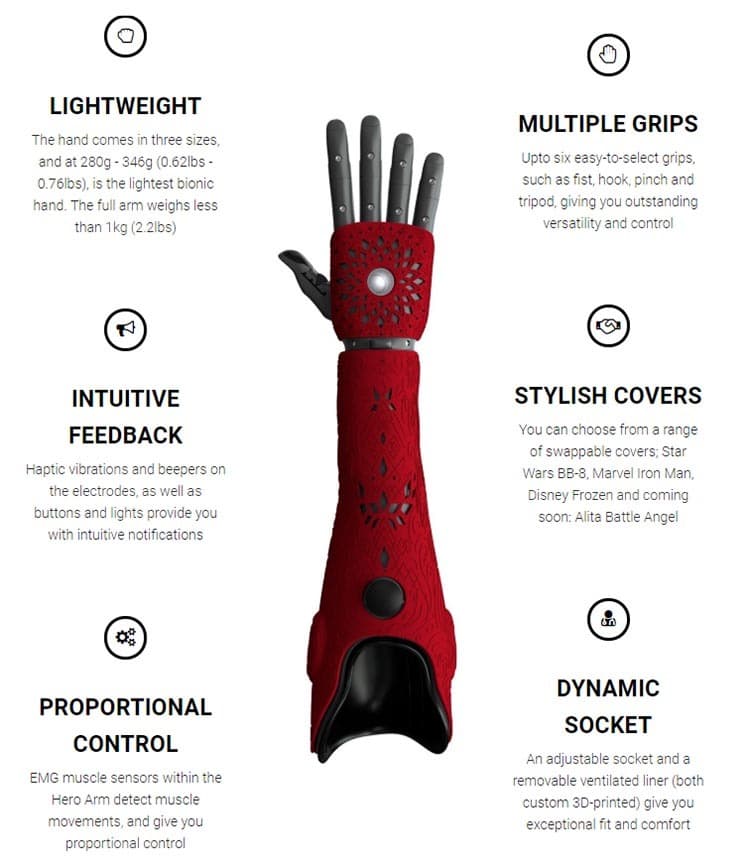When Will Bionic Arms Become More Affordable?
Table of contents

We think it’s pretty well impossible to be a geek about emerging technologies without being a science fiction fan. The best sci-fi isn’t just about hookups between ruggedly pudgy starship captains and hot, oversexed alien chicks. It’s a crystal ball into the future. Take the 1970s TV show The Six Million Dollar Man about an astronaut whose life is saved following a crash by swapping out body parts for bionic parts. It was completely far-fetched at the time, especially thinking that the government could build a human cyborg for just $6 million ($34 million in today’s money, which is merely a hefty downpayment for just one F-35). Nearly 50 years, we’re still waiting for bionic arms that combine human dexterity with the power of a bulldozer at an affordable price. But we’re getting closer.
Advances in Bionic Arms
Earlier this year, for example, a Swedish company called Integrum AB and Chalmers University of Technology announced the first successful surgery to implant a bionic arm into a patient. Generally, such robotic prosthetics rely on electrodes placed over the skin to receive signals from the underlying stump muscles. These so-called myoelectric prosthetics use electrical signals generated by the muscles from the brain, something we talked about with neuroprosthetics. While the technology has helped many people, fine motor skills like tying a shoelace are simply not possible. The new technique out of Sweden involved implanting electrodes in all the remaining stump muscles. The surgery also restored a sense of touch to the prosthetic hand, meaning the recipient could actually perceive when she was grasping an object.
An even more exciting technology promises to link the brain directly with a bionic arm or other robotic prostheses in the near future. Advances in Brain-Computer Interface (BCI) systems would allow a person to control his or her bionic parts with specific thoughts, rather than just generating the electrical impulses at the muscle. As Science Daily explained:
“The thought generates electrical activity in the nerve cells and also brainwaves. A chip can be implanted in the brain to pick up electrical activity or electrodes can be placed on the scalp to pick up brainwaves. In people with paralysis or amputation, BCI can be used to control the movement of muscles, limbs, and prosthetics.”
Researchers are closer than you might think from pulling off this magic trick. In 2016, for example, scientists at the University of Chicago helped a paralyzed man regain his sense of touch through a robotic arm. The same team just got a $3.4 million grant from the National Institutes of Health to take the research to the next level by developing bionic arms that people can control with their minds and also receive sensory feedback from the attached prosthetic hand.
Startups Building Bionic Arms
We looked at three startups a couple of years ago that were developing bionic hands, including a company called Mobius Bionics out of New Hampshire that manufactured the first commercially available, FDA-approved robotic prosthetic arm. Originally developed under a program sponsored by the shadowy government agency known as DARPA (Defense Advanced Research Projects Agency), the LUKE (Life Under Kinetic Evolution) arm isn’t quite as badass as the bionic arm sported by a certain Jedi master, but it’s pretty close. While the exact cost of the bionic arm isn’t listed – you have to undergo various medical exams – the price has been estimated at tens of thousands of dollars. Indeed, some bionic arms can cost upwards of $60,000 or more. That’s why a lot of people are pretty excited about a company called Open Bionics and its 3D printed bionic arm.
3D Printed Bionic Arm
Founded in 2014, Open Bionics is based in Bristol, in the far southwest corner of England. It has scratched out nearly $9 million in disclosed funding over 11 rounds from an eclectic group of investors, including Disney’s seed-stage investment arm. The most recent fund-raising was a $5.9 million Series A in January. Open Bionics has developed the plug-and-play Hero Arm, which is similar to other myoelectric prosthetics in that it requires users to flex muscles in their residual limb, detecting the electrical signals through special sensors and converting them to movement. The Hero Arm has up to six different grips, and these are grouped together in pairs to make switching between them quick and easy. To switch between the different groups, users press the button on the back of the hand. The groups are categorized into such shaolin kung fu moves such as “fist and hook,” “tripod” and “pinch.” It’s also possible to create customized grips through an app. Here’s more on the Hero Arm and the pre-approved Disney styles:

What truly sets the Hero Arm apart is cost, which is currently about $13,000. Open Bionics is able to offer a true bionic arm so cheaply thanks to 3D printing. It first develops the prostheses using 3D scans or plaster casts, then 3D prints each custom-made bionic arm, which not only ensures a great fit but it offers the Hero Arm for tykes as young as 8 years old, so any kids can become like Alita the Battle Angel. The printing process takes about 40 hours, and the company says users can learn to use the Hero Arm in as little as 10 minutes.
Artificial Intelligence for Bionic Arms

The company also says its bionic arm employs artificial intelligence too so that each prosthetic hand learns to understand its user’s gestures better over time, making it an “innate extension” of the user. While it may sounds like another case of a company throwing out AI jargon, researchers have been experimenting with using algorithms to help robotic knees work more smoothly, so maybe letting the machine do some of the thinking is a good idea.


While Brink Bionics is adopting the modular design strategy of a company like BrainRobotics, it explicitly snubs 3D printing as “ultimately impractical and slow when producing large volumes of robotic hands.” Instead, the company plans to use high-quality injection molded polymers and precision-machined metal components for the Axo Hand.
BCI for Bionic Arms

A Bionic Arm Brace
Such a breakthrough could eventually help those whose arms or legs are paralyzed or nearly inoperable from something like cerebral palsy or other neurological or neuromuscular diseases. Until then, a company that trades on the American NYSE, Myomo (MYO), has developed a bionic arm brace for those whose own body parts are nonresponsive either due to disease or injury. We’ve mentioned the company briefly before, but not since it went public in June 2017 after raising about $13.7 million in capital. The stock is trading near its 52-week low at $1.25, so you probably don’t want to rush out and add it to your portfolio. Regardless, the technology seems solid enough, based on research out of MIT and Harvard:

Like other bionic arms, the MyoPro reads the faint myoelectric signals from the surface of the skin, which activates small motors to move the arm and hand, in what Myomo calls “power steering for your arm.” It claims that MyoPro is the first bionic arm for non-amputees.
Conclusion
This must be an exciting time for those living with disabilities that could be helped by a bionic arm, especially with so many companies trying to commercialize more affordable robotic prostheses. But, as they say, hardware is hard. Most of these startups that we’ve featured here seem pretty modestly funded, which is kind of amazing considering the engineering in both hardware and software required. Open Bionics seems to have hit upon a model that is both scalable and economical, though its efforts have been backed, in part, by the U.K. government’s health services. Perhaps a company that specializes in exoskeleton technology with deeper pockets could acquire one of the more promising companies and bring a bionic arm more readily to market.
Sign up to our newsletter to get more of our great research delivered straight to your inbox!
Nanalyze Weekly includes useful insights written by our team of underpaid MBAs, research on new disruptive technology stocks flying under the radar, and summaries of our recent research. Always 100% free.















i live in india and in 2 weeks i am getting a myoelectric hand for under 1,00,000 rupees $1344 with a 3 year warranty
please tell me how this is different than the myoelectric hands more than 10x the cost you have written about above?
That would have been a great question to ask the salesman at the time of purchase 😉 Or maybe you did, any you can clue us in? Who did you buy yours from?
It’s great to see other companies working on improving the wheel. I would have to say Coapt Total Control Gen2 really sets the standard for the best Myo-electric Neural Translators (MeNT for short) I am coining this description and acronym right now! Lol. That’s not what the device is called but it sounded good. 🙂
Anyway, I am an above elbow amputee and have been using a Myo-electric arm for 5 years now with Coapt Gen1 and now Gen2 system. It really did make a world of difference in my abilities and I would recommend them to everyone with similar needs.
That’s great to hear! Thank you for taking the time to comment.
I have a friend who after going to hospital very sick woke up and only had one arm left. It was very hard for her but bound and determined she did her rehab and even though it took months to raise enough money to even get her legs, when she received them they were made unevenly so she walks with limp now. That’s sad that they couldn’t even do that right. She just deals with it. The arm she received just pinches so she doesn’t even wear it. She tends to do more with her stub anyway. I will catch her walking thru her house with knee pads on her stubs because she can get around easier than with her legs on. I see this woman do so much without 3 limbs that she is such an inspiration it is a shame she doesnt have more available to her. It would be wonderful if someday she would be able to afford a robotic arm as well as legs that fit so that she might feel some sort of normalcy again. With only having one arm It is difficult putting all that goes on before putting leg on. Even though she could use the help she does It herself. After all she has been through It amazes me still. It doesnt stop her now but to think what she could do if to have some of that freedom back again. I hope you continue to strive for a more every day affordability to your prosthetics and that maybe people will be able to receive them before leaving hospital vs waiting months or even years before getting them. No one should have to go without in today’s technological world. I know she deserves to be able have more flexibility and to be able to enjoy life a little bit more with ease. But as you know when you are on your own her disability and Medicare will only pay for basics which isn’t all that. But maybe someday she will be able to afford what everyone should have, all four limbs.
Thanks for the story Sheila. Your friend is an inspiration indeed. BTW, there is a firm 3D printing limbs: https://nanalyze.com/2020/01/3d-printing-startups-funding-2019/